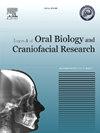有限元应力分析评价和比较不同材料夹板对骨质流失55%牙周受损牙的效果
Q1 Medicine
Journal of oral biology and craniofacial research
Pub Date : 2025-02-10
DOI:10.1016/j.jobcr.2025.01.011
引用次数: 0
摘要
背景:夹板通常用于稳定牙周受损的牙齿,但夹板材料的选择会显著影响牙周韧带(PDL)和周围骨骼的应力分布。本研究旨在利用有限元分析(FEA)评估和比较四种不同的夹板材料-复合材料,纤维增强复合材料(FRC),聚醚醚酮(PEEK)和金属-在骨质流失55%的下颌前牙上的应力分布。方法采用SOLIDWORKS 2020软件建立骨质流失55%的下颌前牙有限元模型。对非夹板牙和复合材料、FRC、PEEK和金属夹板牙进行了模拟。在ANSYS软件中进行垂直(0°100N)和倾斜(45°100N)加载条件下的应力分析。记录PDL和皮质骨的Von Mises应力值,使用MedCalc软件进行统计分析,比较不同夹板材料的性能。结果非夹板牙的应力水平最高,特别是在倾斜加载条件下。在所有的夹板材料中,FRC显示出最有效的减少所有牙齿的应力,特别是在垂直载荷下。复合材料和金属丝夹板提供了适度的应力降低,其性能取决于负载角度。PEEK夹板在垂直载荷下表现出良好的应力降低,但在斜向力下表现出增加的应力水平。这些结果强调了夹板材料和载荷方向对牙周受损牙齿应力分布的影响。结论本研究强调了夹板材料在减少牙周受损牙PDL应力方面的重要作用。在垂直和斜向加载条件下,FRC夹板成为减小应力的最有效材料。复合材料和金属丝夹板提供中等效果,而PEEK夹板在斜载荷下效果较差。这些发现为临床医生选择最佳的牙周固定夹板材料提供了有价值的见解。本文章由计算机程序翻译,如有差异,请以英文原文为准。
Finite element stress analysis to evaluate and compare the effect of splinting in periodontally compromised teeth having 55 % bone loss with different materials
Background
Splinting is commonly employed to stabilize periodontally compromised teeth, but the choice of splint material significantly influences stress distribution within the periodontal ligament (PDL) and surrounding bone. This study aimed to evaluate and compare the stress distribution of four different splint materials—composite, fiber-reinforced composite (FRC), polyetheretherketone (PEEK), and metal—on mandibular anterior teeth with 55 % bone loss using finite element analysis (FEA).
Methodology
Finite element models of mandibular anterior teeth with 55 % bone loss were developed using SOLIDWORKS 2020. Simulations were conducted for non-splinted teeth and for teeth splinted with composite, FRC, PEEK, and metal. Stress analysis was performed in ANSYS software under vertical (100N at 0°) and oblique (100N at 45°) loading conditions. Von Mises stress values in the PDL and cortical bone were recorded and statistically analyzed using MedCalc software to compare the performance of different splint materials.
Results
Non-splinted teeth exhibited the highest stress levels, particularly under oblique loading conditions. Among the splinting materials, FRC showed the most effective reduction in stress across all teeth, especially under vertical loads. Composite and metal wire splints provided moderate stress reduction, with performance varying depending on the load angle. PEEK splints demonstrated good stress reduction under vertical loads but showed increased stress levels under oblique forces. These results underscore the influence of splint material and load direction on stress distribution in periodontally compromised teeth.
Conclusion
The study highlights the critical role of splint material in reducing stress on the PDL of periodontally compromised teeth. FRC splints emerged as the most effective material for minimizing stress under both vertical and oblique loading conditions. Composite and metal wire splints offered moderate efficacy, while PEEK splints were less effective under oblique loads. These findings provide valuable insights for clinicians in selecting optimal splint materials for periodontal stabilization.
求助全文
通过发布文献求助,成功后即可免费获取论文全文。
去求助
来源期刊

Journal of oral biology and craniofacial research
Medicine-Otorhinolaryngology
CiteScore
4.90
自引率
0.00%
发文量
133
审稿时长
167 days
期刊介绍:
Journal of Oral Biology and Craniofacial Research (JOBCR)is the official journal of the Craniofacial Research Foundation (CRF). The journal aims to provide a common platform for both clinical and translational research and to promote interdisciplinary sciences in craniofacial region. JOBCR publishes content that includes diseases, injuries and defects in the head, neck, face, jaws and the hard and soft tissues of the mouth and jaws and face region; diagnosis and medical management of diseases specific to the orofacial tissues and of oral manifestations of systemic diseases; studies on identifying populations at risk of oral disease or in need of specific care, and comparing regional, environmental, social, and access similarities and differences in dental care between populations; diseases of the mouth and related structures like salivary glands, temporomandibular joints, facial muscles and perioral skin; biomedical engineering, tissue engineering and stem cells. The journal publishes reviews, commentaries, peer-reviewed original research articles, short communication, and case reports.
 求助内容:
求助内容: 应助结果提醒方式:
应助结果提醒方式:


